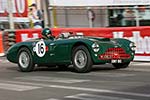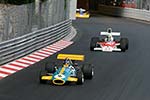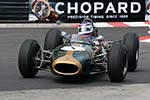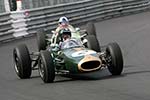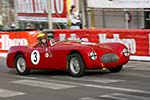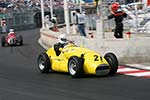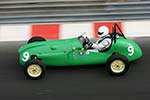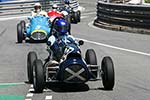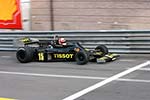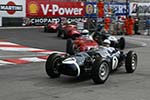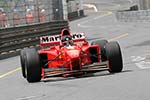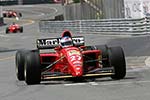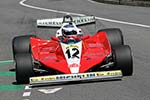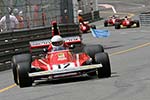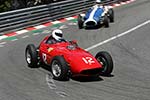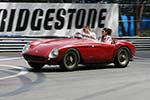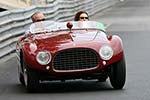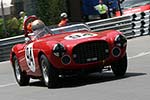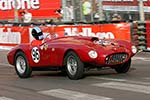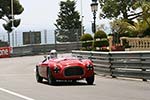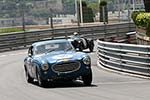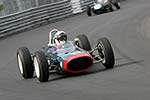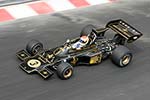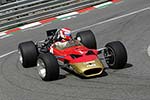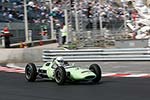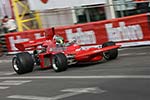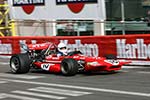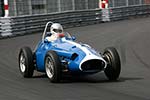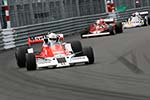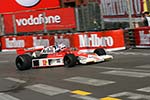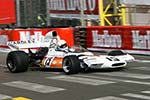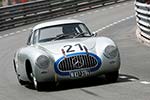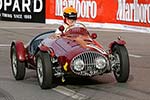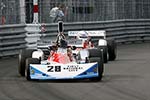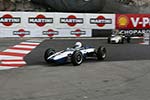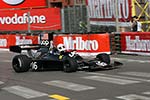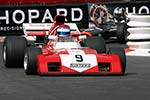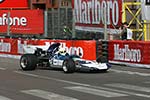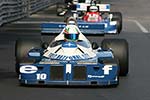Introduction

The Automobile Club de Monaco celebrates the unique and rich heritage of the local Grand Prix with the �Grand Prix Historique� this past weekend. First organized in 1997, the event was given a bi-annual date from 2000, on the weekend before the scheduled Formula 1 race. This peaceful tax-paradise is transformed into a full blown racing track complete with miles of Armco barriers, tire walls and sponsor signs specifically for the races. Since the first Grand Prix de Monaco in 1929, little has changed to the street circuit on which only the sport�s most talented drivers excelled. For various reasons drivers like Alberto Ascari, Graham Hill and Ayrton Senna are forever associated with the race. It is for this reason that the Grand Prix Historique is the premier event for classic single seater racers. All of the current owners/drivers want to feel like Hill or Senna for a minute while piloting their precious cars up the hill to the Casino or roaring through the tunnel. We were in the paddock and trackside throughout the weekend to capture the ins and outs; all of which can be discovered in the following report and an action packed
240-shot slideshow.
Bonham�s Les Grandes Marques a Monaco
No major historic motoring event is complete these days without an accompanying auction and the Grand Prix Historique is no exception. Or so it seems. Located in the Monegasque Royal family�s automotive museum, Bonham�s annual Les Grandes Marques Monaco sale actually celebrated its 12th anniversary and as such is actually older than the Grand Prix Historique. With a large number of vehicles supplied by two major European collections complemented by many other interesting and unique vintage motors, this year�s edition was the largest to date. Earlier this year the news hit our desk that Peter Kaus� incredible collection was sold to a Dutch museum, but in Monaco we learned some cars were still available for interested parties. Many of them had been on display for many years in Kaus� Rosso Bianco museum in Aschaffenburg, Germany. His predominant taste for Italian cars was apparent with this offering consisting mostly of Ferraris, Maseratis and a Lamborghini. A very early Maserati 4CS was the clear highlight and the knowledgeable crowd certainly appreciated the unique �Maser�, which sold for nearly �650,000. Not from the Rosso Bianco collection, but another headliner was the ex-Targa Florio Ferrari 250 GT Lusso, changing hands for a cool �467,000. More unusual cars available included the ex-Erich Honnecker bullet-proof Zil limousine, a very wild George Barris built trike and a Fiat 1100 based �boat�. At the end of the day Bonham�s achieved an impressive �6 million sale total.
The Races
Divided in seven groups, the historic racing cars were carefully selected by Michel Ferry and Jean Sage. The only cars eligible were those that originally raced or could have raced in a contemporary event in the Principality. Naturally all Grand Prix cars from 1929 onwards were welcome, but also a number of sports cars and Formula Juniors that took part in support races. The most modern cars raced were the Formula 1 cars campaigned in Group G for F1 cars from 1975 to 1978. Even newer machinery was driven around in the Ferrari F1 demonstration laps, which saw a 625 F1 take to the track together with the very latest ex-Schumacher cars. Among them was race-director Jacky Ickx with a 312 B2; a car he campaigned in the 1972 World Championship.
All groups were sent on the track twice on Saturday for two 20-minute qualifying sessions. With the limited overtaking opportunities, a good grid position is vital on this street circuit. If anything, the qualifying sessions and races clearly showed that a win at Monaco is something special; even for European standards the racing was extremely close. Combined with the track�s vicious nature, this led to several badly damaged cars.
Group A: Grand Prix cars built before 1947
A colourful mix of mainly Italian, French and British racing cars formed the oldest group out on track ranging from a 1925 Bugatti to a 1946 Maserati. Traditionally this class is dominated by the seasoned ERA voiturettes headed at Monaco by Jost Wildbolz in his A-Type. The ERA party was �spoiled� by Stefan Schollweck, who took pole position in his Maserati 6CM. After topping the first session, Wildbolz was forced to stay in the paddock because of gearbox problems. A faultless race saw Schollweck take the flag first followed by the three remaining ERAs. Behind the lead group a number of non-regular competitors were out on track. Among them the Delage S8 1.5 Jean Claude Milou stood out; a technological masterpiece in its day and a piece of automotive art today. Of similar vintage was Corrado Cupellini�s Maserati 26B, complete with a hand painted body.
Group B: Front engined Grand Prix cars (1947 � 1960)
An Anglo-Italian affair, Group B was headlined by Sir Stirling Moss in the four wheel drive Ferguson. A three time winner of the Monaco Grand Prix, Moss first suffered from brake problems and was later forced to retire from the event after only one session when the driveshaft to the front differential broke. Fifty years after his first victory the legendary racer deserved better luck. His 1956 winning Maserati 250F was more fortunate, unlike two similar cars that were damaged over the weekend. Up front, American Duncan Dayton dominated with his Lotus 16 after his �nemesis� Joaquin Folch-Rusinol retired early on with a similar car. The two would meet again later with more modern material. Behind Dayton a fierce battle for third place unfolded between Jos Koster in a 250F Piccolo and Tony Smith with his 246 Dino, which especially for this race had a new V6 engine fitted instead of the familiar V12 Testa Rossa unit. Eventually only 0.5 seconds separated the two with Koster claiming the final podium position.
Group C: Sports cars constructed before 1953
Because there was a shortage of Grand Prix cars in 1952, a major support race was held over 100 laps for sports cars over 2 litres on Saturday and 65 laps for sports cars under 2 litres on Sunday. To commemorate this unique event there is one sports car group among the hordes of single seaters. The sports car group was highlighted by the actual 1952 winning Ferrari 225 S. A spectacular drive from John Ure in a Frazer Nash Le Mans Replica gave him a well deserved victory.
Group D: Rear engined Formula Juniors
Since 1959, Formula Junior cars were welcomed to the Monaco track as support to the Grand Prix. As the name suggests, the Formula Junior class was set up to allow coming drivers to gain some experience on a pro-level track. Two years ago the front engined cars were invited and now the rear engined examples were back. Seasoned British driver Denis Welch repeated his 2000 victory in his Merlyn, but not without controversy. After the qualifying sessions he complained to the stewards about the pace of Joe Colasacco�s Stanguellini, insisting it had an oversized engine. Unable to examine the engine at the track, the stewards suggested to seal the engines and look at them after the race. Not satisfied, Welch then complained about the striking Italian car having aluminum shock absorbers, which were not available in 1963 and sadly Colasacco was disqualified. Interestingly, two of the three Caravelles built by Robert Hicks in 1960 were present, one driven by his son James.
Group E: Rear engined Grand Prix cars (1954 � 1965)
Mainly covering the exciting, but brief 1.5 litre Formula 1 era, Group E saw an unprecedented number of Climax V8 engined cars on the grid. Powering Lotus, Brabham, Lola and Cooper chassis this tiny V8 was the popular choice in the day, but only make rare appearances in today�s historic races. Even more rare were the two BRMs present and the BRM-engined BRP. In qualifying Michael Schryver in the 2.5 litre engined Lotus 18 dominated, but gearbox and steering rack problems saw him retire early. His place at the top of the leaderbord was taken by a simarly engined Cooper T51 driven by Nick Wigley. James King in his Brabham BT7 was the best of the V8s in third position. James Hanson fielded the unique Scirocco F1 racer, but a variety of problems forced him to retire prematurely from each of the three sessions.
Group F: Formula 1 Grand Prix cars (1966 � 1974)
Now in different cars, Dayton and Folch-Rusinol met once more on the track. The American led most of the race in his Brabham, until the Spaniard passed him during a questionably tight cut across the chicane and crossed the line first in his McLaren. Folch-Rusinol didn't however complain when he was bumped down to second in the official result. The weekend�s two victories combined with those in the previous four editions make Dayton the most successful historic racer at Monaco. Well back in the pack finishing thirteenth, the unique Amon F101 was driven to its first-ever race finish in the hands of Ron Maydon. The problems causing Chris Amon to abandon the project in 1974 seem to have been solved by Maydon�s present-day team. There were also many non-finishers in this class, most of whom fell victim to the track�s unbendable Armco barriers. One of the weekend�s biggest accidents occurred in Group F�s second qualifying session when Jacques Nicolet in the BRM P201 and Andrea Burani in his McLaren M19 collided in the run up the hill towards the casino. The entire left hand side of the McLaren was ripped off as the car got pushed along the barrier. Both drivers fortunately managed to escape unharmed. Further adding to the complexity of the Monaco track was Judy Lyons in her Surtees; she had trouble keeping up with the safety car and served mainly as a rolling chicane.
Group G: Formula 1 Grand Prix cars (1975 � 1978)
In Group G the most modern cars took to the track. It was also the most closely contested group with some daring moves and last lap drama. After qualifying, Martin Stretton's Tyrrell P34 was in a Penske PC3 sandwich with Paul Edwards in front of him and Simon Hadfield behind. In the previous four editions, Stretton had won at least one race, so there was additional pressure on him to continue his streak. A good start saw Stretton jump ahead of the Penske next to him and then reached the first right hander ahead of Edwards and Hadfield. Several accidents brought the safety car out twice and at the second restart Hadfield also managed to get past Edwards. Not giving up, the American did the impossible and passed Hadfield right before the Loews hairpin. In the final lap he tried to pass Stretton on the outside of the hairpin where there clearly was no room. The two exchanged some paint and the charging Edwards was sent off and kissed the barrier. Stretton was understandably delighted with his victory. Italian Mauro Pane was equally ecstatic with his third place finish in a similar six-wheeled Tyrrell. First in class and fourth overall was John Bosch in his Ferrari 312 T3; one of four flat-12 engined Ferraris in the race.
Conclusion
By inviting many of the finest racing cars back to the historic Monaco track, the Automobile Club de Monaco have certainly created a piece of magic. The atmosphere in the paddock was a delight with the drivers and mechanics available for a chat about their car and the event however once the flag dropped it was serious business with many drivers trying to achieve their dream win at Monaco. Sadly several cars were damaged, but the owners have two years for the repairs before the next Monaco Historic Grand Prix. Most competitors will be back for more and so will we!

| |
|
| |
|
|
|
|
| |
|
|
|
|
| |
|
|
|
|
| |
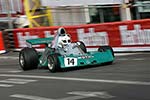
|
|
|
BRM P201
|
9

|
| Years of production: |
1974 - 1975 |
| Last updated: |
05 / 29 / 2006 |
|
|
|
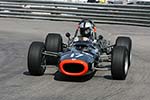
|
|
|
BRM P126
|
31

|
| Years of production: |
1968 - 1969 |
| Last updated: |
04 / 10 / 2015 |
|
|
| |

|
|
|
BRM P48
|
26

|
| Years of production: |
1959 - 1960 |
| Last updated: |
02 / 21 / 2007 |
|
|
|
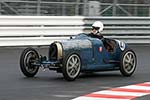
|
|
|
Bugatti Type 35
|
103

|
| Years of production: |
1924 - 1925 |
| Last updated: |
01 / 18 / 2007 |
|
|
| |
|
|
|

|
|
|
Cisitalia D46
|
18

|
| Years of production: |
1946 - 1948 |
| Last updated: |
06 / 06 / 2005 |
|
|
| |
|
|
|
|
| |
|
|
|
|
| |
|
|
|
|
| |

|
|
|
Delage 15 S8
|
49

|
| Years of production: |
1926 - 1927 |
| Last updated: |
10 / 30 / 2006 |
|
|
|
|
| |

|
|
|
ERA R4A
|
6

|
| Produced in: |
1934 |
| Last updated: |
06 / 06 / 2008 |
|
|
|
|
| |
|
|
|
|
| |
|
|
|
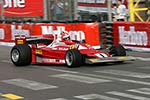
|
|
|
Ferrari 312 T2
|
36

|
| Years of production: |
1976 - 1977 |
| Last updated: |
06 / 06 / 2006 |
|
|
| |
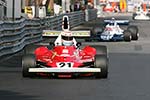
|
|
|
Ferrari 312 T
|
76

|
| Years of production: |
1975 - 1976 |
| Last updated: |
02 / 19 / 2016 |
|
|
|
|
| |
|
|
|
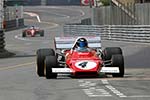
|
|
|
Ferrari 312 B2
|
45

|
| Years of production: |
1971 - 1972 |
| Last updated: |
11 / 28 / 2006 |
|
|
| |
|
|
|
|
| |
|
|
|
|
| |
|
|
|
|
| |
|
|
|
|
| |
|
|
|
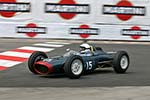
|
|
|
Lola Mk4 Climax
|
21

|
| Years of production: |
1962 - 1963 |
| Last updated: |
04 / 10 / 2008 |
|
|
| |
|
|
|
|
| |
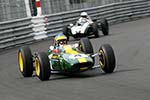
|
|
|
Lotus 33 Climax
|
24

|
| Years of production: |
1964 - 1965 |
| Last updated: |
07 / 03 / 2006 |
|
|
|
|
| |
|
|
|
|
| |
|
|
|
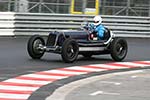
|
|
|
Maserati 8CM
|
120

|
| Years of production: |
1933 - 1935 |
| Last updated: |
05 / 10 / 2017 |
|
|
| |
|
|
|
|
| |
|
|
|
|
| |
|
|
|
|
| |
|
|
|
|
| |
|
|
|
|
| |
|
|
|
|
| |
|
|
|
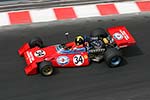
|
|
|
Tecno PA 123
|
22

|
| Produced in: |
1972 |
| Last updated: |
06 / 06 / 2006 |
|
|
| |
|
|
|
|
| |
|
|
|
|
| |

 The Automobile Club de Monaco celebrates the unique and rich heritage of the local Grand Prix with the �Grand Prix Historique� this past weekend. First organized in 1997, the event was given a bi-annual date from 2000, on the weekend before the scheduled Formula 1 race. This peaceful tax-paradise is transformed into a full blown racing track complete with miles of Armco barriers, tire walls and sponsor signs specifically for the races. Since the first Grand Prix de Monaco in 1929, little has changed to the street circuit on which only the sport�s most talented drivers excelled. For various reasons drivers like Alberto Ascari, Graham Hill and Ayrton Senna are forever associated with the race. It is for this reason that the Grand Prix Historique is the premier event for classic single seater racers. All of the current owners/drivers want to feel like Hill or Senna for a minute while piloting their precious cars up the hill to the Casino or roaring through the tunnel. We were in the paddock and trackside throughout the weekend to capture the ins and outs; all of which can be discovered in the following report and an action packed 240-shot slideshow.
The Automobile Club de Monaco celebrates the unique and rich heritage of the local Grand Prix with the �Grand Prix Historique� this past weekend. First organized in 1997, the event was given a bi-annual date from 2000, on the weekend before the scheduled Formula 1 race. This peaceful tax-paradise is transformed into a full blown racing track complete with miles of Armco barriers, tire walls and sponsor signs specifically for the races. Since the first Grand Prix de Monaco in 1929, little has changed to the street circuit on which only the sport�s most talented drivers excelled. For various reasons drivers like Alberto Ascari, Graham Hill and Ayrton Senna are forever associated with the race. It is for this reason that the Grand Prix Historique is the premier event for classic single seater racers. All of the current owners/drivers want to feel like Hill or Senna for a minute while piloting their precious cars up the hill to the Casino or roaring through the tunnel. We were in the paddock and trackside throughout the weekend to capture the ins and outs; all of which can be discovered in the following report and an action packed 240-shot slideshow.






